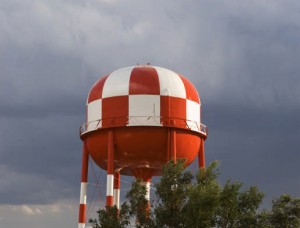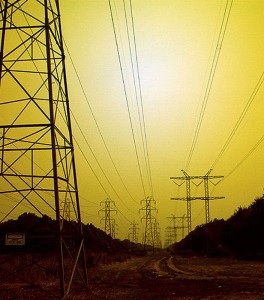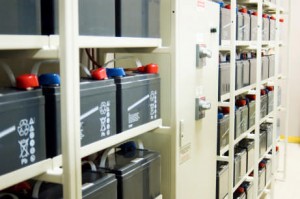There are 52,000 community drinking water systems in the United States that come under the scope of new rules issued by the U.S. Environmental Protection Agency (EPA) to improve public drinking water safety. Compliance with these news rules has significantly increased interest in the use of ultraviolet light (UV) water disinfection systems. However, UV systems are known to shutdown unexpectedly due to power quality problems: leaving the drinking water flow untreated. The purpose of this paper is to discuss the reason for the use of UV disinfection systems and the implications of and solutions for their sensitivity to power quality problems.
New EPA Rules
In January 2006, the EPA published the Long Term 2 Enhanced Surface Water Treatment Rule (LT2 rule) and the Stage 2 Disinfectants and Disinfection Byproducts Rule (Stage 2 DBP rule). The LT2 rule was developed to improve drinking water quality by providing additional protection from pathogenic microorganisms, such as Giardia and Cryptosporidium, that can cause gastrointestinal illness (e.g., diarrhea, vomiting, cramps) and other, potentially life-threatening, health risks. In 1993, Cryptosporidium caused 400,000 people in Milwaukee to experience intestinal illness. More than 4,000 were hospitalized, and at least 50 deaths have been attributed to the disease.
 To protect drinking water from these pathogens, water suppliers often add a disinfectant to drinking water such as chlorine. However, certain microorganisms, such as Cryptosporidium, are highly resistant to traditional chemical disinfection practices. Furthermore, the chemicals themselves can react with organic materials in the water to form byproducts, such as trihalomethanes (TTHM) and haloacetic acids (HAA5), which may pose health risks. The Stage 2 DBP rule was established minimize the health risks to the population from disinfection byproducts.
To protect drinking water from these pathogens, water suppliers often add a disinfectant to drinking water such as chlorine. However, certain microorganisms, such as Cryptosporidium, are highly resistant to traditional chemical disinfection practices. Furthermore, the chemicals themselves can react with organic materials in the water to form byproducts, such as trihalomethanes (TTHM) and haloacetic acids (HAA5), which may pose health risks. The Stage 2 DBP rule was established minimize the health risks to the population from disinfection byproducts.
The LT2 rule applies to all public water systems that use surface water or ground water under the direct influence of surface water. This includes about 14,000 systems serving approximately 180 million people in the U.S. The DBP rule applies to approximately 75,000 systems; a small subset of these will be required to make treatment changes.
The LT2 rule requires that affected public water systems commence 24 months of water monitoring for pathogens by October 2008, and then affect necessary disinfection programs and within 3 years. Public water systems already disinfecting to prescribed levels are exempt from the monitoring. Monitoring and corrections under the Stage 2 DBP rule commence in 2012 and run through 2016.
UV Disinfection Technology
Prior to issuing the new rules, the EPA conducted technology and cost analyses to ensure that enactment of the new rules was feasible. One of the more promising technologies evaluated was ultraviolet (UV) water disinfection. The EPA estimated that increasing capacity and falling costs of UV systems would significantly increase interest in this technology.
Unlike chemical disinfectants that kill microorganisms by damaging cell structure or interfering with metabolism, UV light destroys the microorganism’s ability to reproduce. The inability to reproduce renders the microorganism harmless since it cannot infect a host. UV disinfection is much more effective in controlling Cryptosporidium and other microorganisms than conventional chemical treatments, like chlorine and chloramine, and has the added benefit of producing no disinfection byproducts.
Power Quality and UV Disinfection
In recommending UV systems as a likely solution for the LT2 and Stage 2 DBP rules, the EPA suggests that a power quality review should be considered as part of the planning process for installing a UV system. Recognizing the sensitivity of UV systems, the EPA also evaluated the costs of UV systems with and without UPS (uninterruptible power supply) units.
Chemical disinfection can remain active in the water well after the point of injection, but UV treatment only works while the microorganism are in the presence of the UV light. If the UV lamps are off or not working at optimum capacity, the water is not being properly treated and the facility is probably in regulatory non-compliance.
 UV systems have demonstrated a low tolerance to voltage sag events which are common for most electric utility customers. The voltage sag is a reduction in voltage below 90% of nominal for more than one-half electrical cycle (8 ms). Studies by the Electric Power Research Institute (EPRI) suggest that a typical utility customer experiences 40 to 60 sag events per year of varying intensity and duration. Since voltage sags are caused by events beyond the control of the utility (e.g. lightning, wind and equipment failure), protection of sensitive equipment from voltage sags becomes the burden of the end user.
UV systems have demonstrated a low tolerance to voltage sag events which are common for most electric utility customers. The voltage sag is a reduction in voltage below 90% of nominal for more than one-half electrical cycle (8 ms). Studies by the Electric Power Research Institute (EPRI) suggest that a typical utility customer experiences 40 to 60 sag events per year of varying intensity and duration. Since voltage sags are caused by events beyond the control of the utility (e.g. lightning, wind and equipment failure), protection of sensitive equipment from voltage sags becomes the burden of the end user.
The most common types of UV lamps have restart times on the order of 5 to 10 minutes once they shut off. Some lamps even require a cool down period before they can be restarted. The long restart time and the frequency of voltage sag events create a problem for the water facility: being out of LT2 rule compliance for hours or days each year. Additionally, the frequent starting and stopping of UV lamps can significantly reduce their life – increasing maintenance costs and potentially creating additional non-compliance situations.
The unexpected shutdown of a UV system can be very problematic. Because of the large volume in most facilities, abruptly shutting off the water flow is not practical and may lead to equipment damage. Backup disinfection systems can require their own startup time and represent a significant additional cost to the water facility. Diverting un-disinfected water back into the untreated water supply is costly.
A more direct and effective solution to maintaining LT2 rule compliance is to keep UV systems operating by protecting them from voltage sags.
 UPS units use energy stored in lead acid batteries to provide power to a load when the incoming voltage falls below a prescribed level. The typical UPS operates with an electrical efficiency below 90% and requires frequent maintenance and lead acid battery replacement. This makes the O&M costs of a UPS quite substantial and is likely the reason that the EPA felt it necessary to evaluate UV system costs with and without a UPS.
UPS units use energy stored in lead acid batteries to provide power to a load when the incoming voltage falls below a prescribed level. The typical UPS operates with an electrical efficiency below 90% and requires frequent maintenance and lead acid battery replacement. This makes the O&M costs of a UPS quite substantial and is likely the reason that the EPA felt it necessary to evaluate UV system costs with and without a UPS.
Flywheel systems can provide sag protection with better electrical efficiency and lower maintenance costs than a UPS with lead acid batteries, however products specifically designed for sag protection, like UST’s SagFighter brand power conditioner, offer the lowest O&M costs. Following is a cost analysis (in constant $US2008) of a battery-free sag protection device and a UPS for protection of a UV system in a medium sized drinking water facility:
Owning Cost Comparison between a 500 kVA UPS
with 5 minutes of runtime and a 500 kVA sag protection unit
| UPS | Sag Protection Unit | |
| First cost, typical installation | $210K | $110K |
| Annual service contract | $7K | N/A |
| Annualized wear parts (batteries)* | $17K | N/A |
| Annual energy losses** | $39K | $4K |
| Total annual operation & maintenance cost | $63K | $4K |
| 10 year total owning cost (First cost + 10 x annual O&M) | $840K | $150K |
**UPS - 90% efficiency; Sag protection unit – 99% efficiency; Electric cost - $0.10/kw-hr
Over 10 years, a single 500 kVA UPS would waste more than 3.5 million kW-hrs of electricity compared to the sag protection unit, not including the energy required to produce, transport and dispose of its batteries. Besides the O&M costs, the use and handling of lead acid batteries require special measures be taken for personnel safety, to avoid the accumulation of hydrogen gas and for hazardous waste disposal.
It is worth noting that the UPS will provide power to a UV system during a power interruption while the sag protection device will not. However, the value of this capability has to be examined in context of the larger scheme. During a power interruption lasting more than a few seconds, the whole facility will shutdown unless all of the equipment is protected by some type of energy storage system like a UPS. Typically, there is little value in permitting the UV system to operate while the rest of the facility is offline since the time required to restart a facility can easily be 10 minutes or more.
Sag protection units minimize O&M costs and the special requirements dictated by lead acid batteries. By eliminating the need for regular maintenance and battery replacement, sag protection units also have a higher availability and reliability than UPS units.
Voltage sags affect every electric utility customer but the random nature of sag events makes them difficult to record during a typical power quality audit. The relatively low owning cost of sag protection units can make the economic decision of whether or not to install sag protection for UV disinfection systems much easier.

